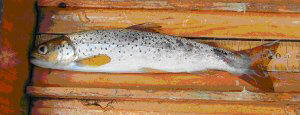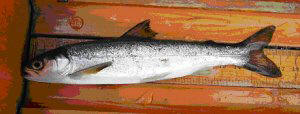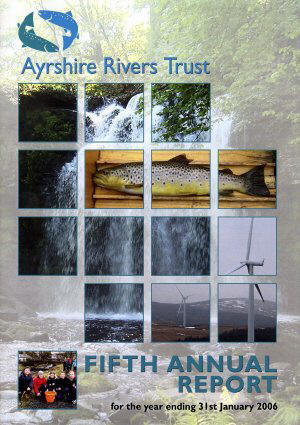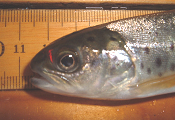September 2006 – Fisherman’s Supper
This year the Fisherman’s Supper will be held at the Cariston Hotel in Ayr on Friday 20th October. The evening will include a guest speaker, an excellent meal and the opportunity to meet anglers from across Ayrshire and beyond. There will also be a raffle with a variety of fishing-related prizes.
For tickets please contact Janette Galbraith on 01292 525142
or email info@ayrshireriverstrust.org Discounts are available for group bookings; tickets are £20 each or £190 for a table of ten. We look forward to seeing you there!
Investors in People
 Ayrshire Rivers Trust received Investors in People accreditation on 5th July 2006. Senior biologist Brian Shaw said: “We are very pleased to receive this award. The Trustees and staff have recently spent a great deal of time and effort developing and formalising the Trust’s working procedures and practices. This award goes a long way towards achieving recognition for the Trust as a professional organisation.” Investors in People was set up to accredit companies and organisations which follow good working practices, such as the provision of appropriate training programmes for staff, accurate record keeping and strict adherence to Health and Safety legislation.
Ayrshire Rivers Trust received Investors in People accreditation on 5th July 2006. Senior biologist Brian Shaw said: “We are very pleased to receive this award. The Trustees and staff have recently spent a great deal of time and effort developing and formalising the Trust’s working procedures and practices. This award goes a long way towards achieving recognition for the Trust as a professional organisation.” Investors in People was set up to accredit companies and organisations which follow good working practices, such as the provision of appropriate training programmes for staff, accurate record keeping and strict adherence to Health and Safety legislation.
Hot weather
The hot weather during July 2006 triggered algal blooms on several lochs. Large numbers of brown trout died at Loch Melemon, near Ballantrae during an algal bloom. It was not possible to establish whether the fish died as a result of a toxin produced by algae or low oxygen levels. Some types of algae, also known as ‘blue-greens’ or cyanobacteria, can produce substances toxic to fish and other animals.
Low oxygen levels can occur in lochs during the summer, especially at night when aquatic plants continue to use up oxygen but do not produce any, unlike during the day. During the day plants produce oxygen by photosynthesis but at night there is often a drop in dissolved oxygen levels when photosynthesis stops.
Loch Melemon is shallow which means there is no opportunity for fish to escape to deeper, cooler water. Cooler water retains oxygen more effectively and the metabolic rate and oxygen demand of the fish is lower at lower temperatures. Salmonids often show signs of stress at water temperatures over 25ºC and may die at 30ºC. Apparently a similar event occurred on Loch Melemon during the hot summer of 1976.
Treated sewage entering River Lugar near Cumnock |
TheTrust also did some investigations of oxygen levels in rivers during July. Levels likely to cause stress to salmonids were found on the River Lugar just downstream of Cumnock. Nutrient inputs from the sewage works at Underwood and diffuse pollution from livestock are suspected.
Nutrient overload results in rapid instream algal growth during hot weather, with resulting drops in oxygen levels, again most noticeably at night. The Trust provided the Lugar results to SEPA who have now agreed to investigate the matter further, as part of an Environmental Improvement Action Plan. |
Fish parasite
Several reports were received from anglers in 2006 of a strange parasite found attached to the skin of brown trout and grayling caught in the River Ayr. The Trust was able to confirm that the parasite was Argulus, a freshwater crustacean which feeds on fish blood and can result in fish death. Samples sent to the government’s Fisheries Research Service (FRS) laboratory were confirmed as Argulus foliaceus, the most common form of the parasite. Argulus has two black eye spots and does not grow a tail of eggs unlike the more commonly seen marine lice, Lepeoptheirus and Caligus.
Marine lice are often seen on salmon and sea trout which have just entered the river from the sea. These lice soon drop off following entry into freshwater. In contrast, Argulus is only present in freshwater conditions and can parasitise many fish species. It can attach to salmon but is more likely to be seen on trout or coarse fish such as roach or rudd. The parasite is believed to have been in the River Ayr for many years but may have been introduced by the movement of fish from other areas. It is possible that the hot weather in 2006 triggered a sudden increase in their numbers, as fish often become susceptible to parasites during warm weather and low flow conditions.
Carp dumped by M77
Common carp captured by M77, near Fenwick |
In September 2006 the Trust biologists discovered a common carp while surveying streams in the Fenwick area. It appears that the 6lb carp was dumped in a settlement pond next to the M77 and subsequently escaped into a small stream via a drainage channel. The fish was badly injured during its passage down the steep channel.
Trust biologist Pete Minting said: “Whoever dumped this fish was very irresponsible, both in terms of disregarding animal welfare and the introduction of non-native species.” The common carp is not native to Ayrshire, although carp are known to have been introduced to a few ponds and small lochs. The carp would have been unlikely to survive in the stream into which it escaped, or the settlement pond in which it was dumped. The settlement ponds collect run-off from the motorway and water quality is likely to be poor. Anyone found dumping animals in places such as this could face prosecution by the SSPCA.
Introduction of non-native species is a major problem for Ayrshire’s wildlife. Several non-native fish now compete with native fish species in Ayrshire. One of the major culprits is the stoneloach or ‘beardy’ which may have been introduced by anglers using live bait. Perch have been introduced to Loch Doon, where they threaten the survival of Ayrshire’s endangered and unique population of Arctic char. Introduced species can carry disease, as in the case of American signal crayfish, which carry crayfish plague. This disease has decimated stocks of native white-clawed crayfish in English rivers. Laws on the introduction of non-native species may soon be tightened up, in proposed changes to the Freshwater Fisheries Bill.
Smolt trap results, River Doon
|
|
|
Sea trout smolt with red polymer tag, in front of left eye. Four different positions and four colours (red, blue, green and yellow) were used to create different marks. |
The results of the smolt trap project show that in 2006 around 25,000 salmon smolts were produced by the River Doon upstream of Dalrymple. Many more smolts will have been produced from the main River Doon and tributaries downstream of Dalrymple. This preliminary study provided some interesting information about smolt production from the upper two-thirds of the River Doon.
Only 4.5% of smolts captured in the River Doon trap were sea trout, very similar to the current ratio of rod catch for sea trout relative to salmon (4.8%). Before 1990 the rod catches of sea trout in Ayrshire were much higher and it is possible that if a smolt trap had been operated during this time, a greater proportion of sea trout smolts would have been captured. The results from the trap in 2006 show that there is still a small number of sea trout in the River Doon from which a larger population of sea trout could be generated. The causes of the sea trout decline in Ayrshire remain unknown.
In order to generate a population estimate, smolts were given a coloured tag and released upstream of the trap. The number of tagged recaptures relative to untagged was then used to generate an estimate of population. In total 1392 salmon smolts were captured, 1079 of which were tagged and re-released. A total of 61 salmon smolts were recaptured. The number of sea trout captured (62) was unfortunately too small to generate an estimate of population.
A cold spring seemed to delay the start of the smolt run until 21st April, with smolts captured regularly once the water temperature exceeded 8ºC. The peak of the salmon smolt run was on May 2nd (434 unmarked smolts) and sea trout later on May 4th. Increases in the number of smolts captured occurred following heavy rain and increases in river flow. The trap was operational from March 18th – May 17th. This research project was funded by the River Doon Salmon Fishery Board.
 |
 |
|
| Sea trout smolt (with bird damage to the tail). The trout has a much larger mouth and shallower-forked tail in comparison with the deeply-forked tail of a salmon. | Salmon smolt. Salmon smolts rarely have spots below the lateral line, in contrast to the sea trout smolt shown to left. Salmon smolt also has dark fins and a mouth which only extends as far back as the centre of the eye. |
Background
Juvenile salmon and sea trout typically turn silver and migrate to sea in the spring. Sometimes it is possible to see large numbers of these fish as they migrate downstream. Salmon in Ayrshire tend to turn silver or ‘smolt’ at around two years of age, with trout migrating at a variety of ages. Not all trout migrate to sea, many remain in freshwater as brown trout.
In many other areas of the UK smolt traps have been set up to assess the size and timing of the smolt runs. This can provide a lot of information on the productivity of the river in terms of salmon and sea trout, the age of the fish when they smolt and how the timing of the run changes with climate.
Interesting findings include the observation that salmon now smolt at a younger age compared to 50 years ago. This may be linked to climate change. The nearest smolt traps to Ayrshire are on the River Bladnoch in Wigtownshire and Loch Awe in Argyll.
Electrofishing and invertebrate surveys in 2006
The Trust has now completed its annual surveys of fish and invertebrate populations on the Rivers Ayr, Doon, Girvan and Stinchar. The information collected still needs to be analysed but early indications suggest 2005- 6 was a good year in terms of salmonid spawning and fry production. No evidence of acute pollution was discovered by the invertebrate surveys this year, unlike last year when sheep dip pollution was found on the Girvan. However evidence of diffuse pollution from agriculture and sewage was found in many lowland areas and in upland areas, acidification linked to forestry. A new combined pH, oxygen and conductivity meter has been very useful in terms of collecting data from sites where an impact is suspected. The new meter was funded by Awards for All and the Minerals Trust.
The Trust is still completing several surveys of fish and invertebrate populations on proposed windfarm sites. This information is being collected for the developers, who are required to produce Environmental Statements as part of the planning process.
April 2006 – Country Fair, Auchincruive
This year the Trust will be holding its Country Fair at Oswald Hall, Auchincruive Estate on Sunday 21st May, 2006. The Fair will be signposted from the Heathfield roundabout on the A77 near Ayr and will be open from 11am-5pm. The Fair will be next to the River Ayr with free access to river walks with beautiful scenery. Stalls at the Fair will include local arts and crafts, a working beehive and honey seller, a falconry display and plenty of games for the kids. There will be an information stand hosted by Ayrshire Rivers Trust where visitors can find out more about local rivers and the work of the Trust.
Annual Report 2006
 This year’s Annual Report is now available, for the period January 2005 – January 2006. The report contains a wealth of information on work recently completed by the Trust. The Trust has continued to develop and move into new areas of research. New studies include invertebrate monitoring and sea trout research. Summaries of other major projects, such as the River Garnock Habitat Survey are included. The report also includes details of habitat restoration work over the past year. For a copy, please contact the Trust.
This year’s Annual Report is now available, for the period January 2005 – January 2006. The report contains a wealth of information on work recently completed by the Trust. The Trust has continued to develop and move into new areas of research. New studies include invertebrate monitoring and sea trout research. Summaries of other major projects, such as the River Garnock Habitat Survey are included. The report also includes details of habitat restoration work over the past year. For a copy, please contact the Trust.
Staff changes
George Steel recently became Trustee and Treasurer of Ayrshire Rivers Trust, having worked tirelessly as Trust Administrator since the Trust began in 2001. At the same time the Trust has decided to appoint a new Administrator to work in the office alongside the biologists. As the Trust has expanded its range of research the volume of work has increased considerably. The new Administrator will take charge of many administrative duties relating to fundraising and office maintenance, allowing the biologists to spend more valuable time on management and research.
Smolt trap in operation
The Trust has started a new project to assess smolt production on the River Doon. Salmon and trout turn silver and become ‘smolts’ when they are ready to migrate to sea. By trapping, marking and releasing salmon and sea trout smolts on the River Doon, the biologists are hoping to work out how many smolts the river produces. Smolts will be trapped at a location low down on the river system. Productivity can then be assessed from this point upstream.
Smolts which have been trapped will be measured, counted, identified to species and marked. Different marks will be used for each day of the project. Marked smolts will be transported 1km upstream and re-released. The number recaptured will then be used to generate a total production estimate. It is hoped that enough fish will be trapped to generate production estimates for salmon and sea trout.
The trap is now in place and has been functioning well since installation on 18 March. The smolt run is expected to take place from early April to late May but extra monitoring will take place to make sure fish are not missed. The River Doon has suffered a decline in the sea trout rod catch, in common with the majority of rivers on the west coast of Scotland.
Combined with the work the Trust is doing on estuarine sampling of sea trout in Ayrshire and on Arran, this research should eventually help solve the mystery of the sea trout decline.


